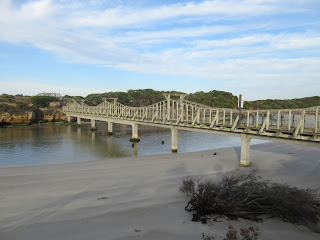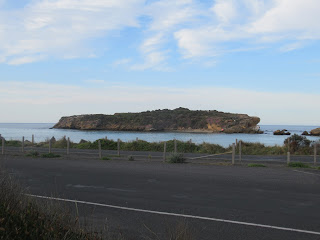The Limetone Coast
We walked from our hotel along the coast towards our breakfast stop. This is the footbridge over the Merri River in Warrnambool.A view of Middle Island and home to Fairy Penguins. Although it is an island, they were being devastated by foxes, feral cats and other predators as it is easily accessible at low tide. The colony had shrunk to just 11 adults. A solution was introduced in 2006. A pair of maremma dogs were introduced to the island. These are guardian dogs originally from Italy. They were used to guard sheep against wolves. On their first tour of duty, the dogs protected six breeding pairs who produced 11 chicks.
The first two dogs used on the island were local to Warrnambool who had been guarding free range hens. They were Oddball and Missy. It was an experiement but it was a massive success. There were no more penguin kills and no fox prints seen on the island. The next season saw Electron and Neve guarding the penguins with equal success. The point had been proved. The next season Maremma dogs Eudy and Tula were introduced to the island and undertook guardian duties for a decade. During the breeding season, the dogs are on the island, humans are barred and the penguins thrive with now over 180 breeding pairs.
We walked on to the cafe overlooking the harbour, the islands, the bay and of course the sea.
The beach by the cafe was also a frequented place for a local stable who exercised their horses here in the sea.
We stopped at Tower Hill, previously called Koroitj by the aboriginals. It is a former volcano that eruoted 36,000 years ago. Aboriginals have been in Australia for 65,000 years, so the eruption would have by witnessed by humans.
There is a lake in the caldera with an island in the centre and a causeway across the shallow lake to connect the island to the shorw. It is not a nature reserve but we were hopeful of seeing some wildlife.
Even before we reached the car park, we saw a koala...
...and a magpie, same name as back in UK but the markings are different.//
...and several emus.
We were going to leave Victoria and cross into South Australia. The name is a mouthful so in typical Aussie style, it is shortened to just SA. SA has strict rules to protect its agriculture from friut flies and several other pests and disesses. Entrants are not allowed to bring in any plants, fruit or vegetables. There are plenty of signs warning people and quarantine bins are provided for people to dispose of their offending items. There is no border buildings or cones, just signs to welcome you to SA. And traffic cones are not called cones, they are called witches hats.
We walked on to the cafe overlooking the harbour, the islands, the bay and of course the sea.
The beach by the cafe was also a frequented place for a local stable who exercised their horses here in the sea.
We stopped at Tower Hill, previously called Koroitj by the aboriginals. It is a former volcano that eruoted 36,000 years ago. Aboriginals have been in Australia for 65,000 years, so the eruption would have by witnessed by humans.
There is a lake in the caldera with an island in the centre and a causeway across the shallow lake to connect the island to the shorw. It is not a nature reserve but we were hopeful of seeing some wildlife.
Even before we reached the car park, we saw a koala...
...and a magpie, same name as back in UK but the markings are different.//
...and several emus.
We were going to leave Victoria and cross into South Australia. The name is a mouthful so in typical Aussie style, it is shortened to just SA. SA has strict rules to protect its agriculture from friut flies and several other pests and disesses. Entrants are not allowed to bring in any plants, fruit or vegetables. There are plenty of signs warning people and quarantine bins are provided for people to dispose of their offending items. There is no border buildings or cones, just signs to welcome you to SA. And traffic cones are not called cones, they are called witches hats.
On the main highway, police occasionally flag down traffic on the border to inspect vehicles, especially if they have an outbreak of fruit flies to enforce the rules. Mostly, people are honest and follow the rules.
Our first stop in SA was at Mount Gambier and the Blue Lake. The mountain was seen from a distance and named after Lord Gambier and the settlement was named after the mountain. It is a former volcano. A hotspot developed underneath the limestone and burst through the layers of sedimentary rock depositing basalt and ash above the limestone. On a sunny day the lake is a vivid blue due to the concentration of calcium carbonate in the water.
The lake also supplies the city with water, with two massive pipes drawing water up from the lake. As it is the town's water supply, no swimming, fishing, boating or any other water activity is allowed on the lake.
Another view of the lake.
We stopped in the town centre for lunch. I wanted a scallop pie but the bakery didn't have any so I settled for a beef pie. There are lenty of interesting buildings in the centre. The fretwork on the verandahs and boardwalks are made of metal which was brought to Australia as ballast in ships
As with any area of limestone, there are several caves and sinkholes. In the centre of the town is a sinkhole. It has been carefully manicured into a garden, a piece of quiet i the centre of the city.
More intersting old buildings...
...and others...
...
...
We drove through Penola. It is where Mary MacKillop (1842 - 1909) established a school for the poor and founded The Sisters of St Joseph. She is Australia's only saint.
We didn't stop in the town as we had an appointment at Wynns Coonawarra Estate for a wine tasting. The terra rosa (red earth) that defines the wines of the Coonawarra Estate has been developing for the last 120,000 years since the last wet interglacial period. Clay and silt weathered during the formation of the shallow lagoons and dune systems to the west have been deposited by winds on the Coonawarra estate. The redness of the light clay has deepened as iron compounds oxidised. Below the terra rosa, calcium carbonate has been dissolved from the limestone to form a band of very hard calcrete. Further below lies a layer of limestone marl that is kept moist by a water table that lies five metres below the surface which is replenished by the winter rainfall. The roots of the vines delve into the deep terra rosa but rarely penetrates the limestone. The restriction of the roots to water means they only produce small grapes but they are intensely coloured and flavoured. These grapes produce some great wines. This particular geological area only covers an area of 27 kilometres by two kilometres. Grapes are also grown nearby but the geology is different and so the grapes produce a different quality wine.
Our first stop in SA was at Mount Gambier and the Blue Lake. The mountain was seen from a distance and named after Lord Gambier and the settlement was named after the mountain. It is a former volcano. A hotspot developed underneath the limestone and burst through the layers of sedimentary rock depositing basalt and ash above the limestone. On a sunny day the lake is a vivid blue due to the concentration of calcium carbonate in the water.
The lake also supplies the city with water, with two massive pipes drawing water up from the lake. As it is the town's water supply, no swimming, fishing, boating or any other water activity is allowed on the lake.
Another view of the lake.
We stopped in the town centre for lunch. I wanted a scallop pie but the bakery didn't have any so I settled for a beef pie. There are lenty of interesting buildings in the centre. The fretwork on the verandahs and boardwalks are made of metal which was brought to Australia as ballast in ships
As with any area of limestone, there are several caves and sinkholes. In the centre of the town is a sinkhole. It has been carefully manicured into a garden, a piece of quiet i the centre of the city.
More intersting old buildings...
...and others...
...
...
We drove through Penola. It is where Mary MacKillop (1842 - 1909) established a school for the poor and founded The Sisters of St Joseph. She is Australia's only saint.
We didn't stop in the town as we had an appointment at Wynns Coonawarra Estate for a wine tasting. The terra rosa (red earth) that defines the wines of the Coonawarra Estate has been developing for the last 120,000 years since the last wet interglacial period. Clay and silt weathered during the formation of the shallow lagoons and dune systems to the west have been deposited by winds on the Coonawarra estate. The redness of the light clay has deepened as iron compounds oxidised. Below the terra rosa, calcium carbonate has been dissolved from the limestone to form a band of very hard calcrete. Further below lies a layer of limestone marl that is kept moist by a water table that lies five metres below the surface which is replenished by the winter rainfall. The roots of the vines delve into the deep terra rosa but rarely penetrates the limestone. The restriction of the roots to water means they only produce small grapes but they are intensely coloured and flavoured. These grapes produce some great wines. This particular geological area only covers an area of 27 kilometres by two kilometres. Grapes are also grown nearby but the geology is different and so the grapes produce a different quality wine.
The next stop was at the Naracoorte Caves National Park. There are multiple caves and cave systems but we were only going to the Alexandra Cave.
There are lots of fossils in the limestone but the caves also have revealed complete skeletons of megafauna plus many other animals. There are many sinkholes in the area and animals have slipped into them and are killed straight away, die of their injuries or they survive the fall but die of starvation.
Near the entrance is a reproduction of a giant wombat standing more than two metres tall. Modern wombats don't even reach an adult's knee.
There are stalactite and stalagmites.
And other odd formation such as this ripple effect...
Hanging points......a mass of formations...
...the Wedding Cake...
...and the Straws.





























No comments:
Post a Comment